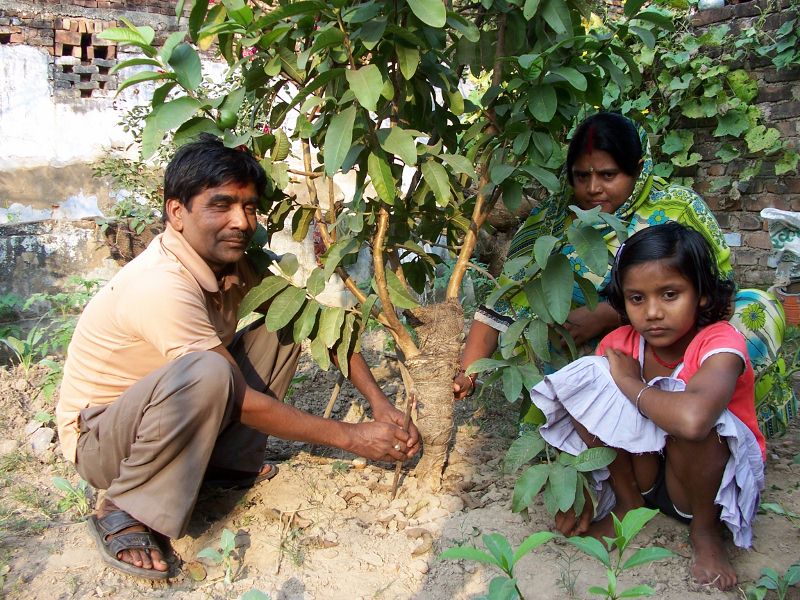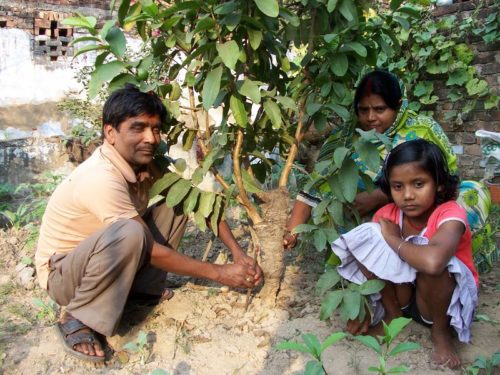TBI Specials: A Village In Bihar Is Greeting Every New Born Daughter With Fruit Trees
A nondescript village in Bihar is showing the way with its innovative way of celebrating the birth of a girl child - by planting at least 10 fruit trees! They are tackling declining sex ratios, global warming and climate change - all at once!

There is a small, nondescript village in Bihar that has found a great way to tackle declining sex ratios, global warming and climate change, all in one go. Theirs is a solution that incorporates tradition as well as knowledge of farming and it has been in practice for decades now.
Generally, the flood-ravaged districts of eastern Bihar present a scenario of abject poverty and poor development. But Dharhara is an exception. Located about 20 kilometres from the district headquarters of Bhagalpur, this village is one of the greenest pockets of the region. And that’s not all. Unlike elsewhere, for years now girls in this village have been welcomed into the world in the most novel way: By the local community planting at least 10 fruit trees – traditionally mango – in celebration. New daughters here are treated as avatars of Goddess Lakshmi and stand to inherit these fruit trees as they grow up.

Owing to the tradition, this green village – which is surrounded by the river Ganga to the south and the unpredictable river Kosi to the north-east – is today nestled in the midst of more than 20,000 fruit-bearing trees. Sukriti, the young daughter of the village pradhan, Parmanand Singh, says, “Even as the world is frantically discussing how to deal with issues like sex selective abortions, global warming and the carbon footprint, planting trees when girls are born is our simple solution to all these complicated problems.”
In the highly prejudiced Bihari society, where girls are generally seen as a financial ‘bojh’ (burden) on the family, dowry deaths that were once so common here no longer make the news. Planting trees to celebrate the birth of a girl child is essentially a move to build an asset base for her, which can eventually be utilised by the family to finance her education and future development. Former pradhan, Pramod Singh, puts it this way,
She inherits the trees and over the years the fruit not only helps support her family it also helps them bear the expenses of her wedding. We plant the trees at birth because as our girls grow up, so do the trees.
Pramod had planted 10 mango trees about 12 years ago when his daughter, Niti, was born. Niti now goes to school and neither her father nor other family members consider her school fees a burden since the money comes from selling the fruit from her trees. Of course her very traditional mother, Rita Devi, has taken to planning for her marriage already and sees Niti’s trees as an asset in that context.
The unfortunate social practice of dowry may take many more years, or even generations, to overcome, but Madhurani, 20, who got married a couple of years back and is a proud mother of a three-month-old daughter, chooses to be optimistic, “Of course we know we cannot completely remove the practice of dowry from our social system, but at least having some assets in their name have given our girls and their families a better life.”
Adds Gul Afsan, an activist with the NGO, ‘Her Initiative’, which works for the empowerment of poor women through entrepreneurship, “Although the purpose of planting these trees is to build an asset for the future of local girls, it has also helped them develop a sense of ownership – rare among women of this region.”
For now, the 8,000 villagers of Dharhara, including scores of young girls, are enjoying the fruits of their labour. In Bhagalpur, a district well-known for mangoes, a tree takes around four to five years to mature and then, with some care, they start yielding bumper crops every season. While the greater part of the produce is sold, some of it is kept aside for the children to enjoy. Says Nirmala Devi, a mother of three, “My daughters love to eat mangoes and I don’t stop them since it’s good for their health.”

Planting mango is also profitable because once the trees become old they can be felled for wood, which is in great demand in the low-cost furniture market. “We cut the trees over a period of several years for the wood and all the furniture that is customarily presented to girls during marriage is made from this,” adds Nirmala.
Nivedita Singh, 20, who recently got married to a schoolteacher working in a nearby village, explains, “Another reason for this trend is that the amount of labour needed to work in orchards is much less. One only needs to be patient for a few initial years and then it only gets better.” Her parents, too, did not have to worry about money for her education or marriage, as her trees were there to support them.
These trees have also impacted cultivation patterns in this region. Notes Parmanand Singh, “People in our village have been tilling land as a means of livelihood for generations. But, of late, there has been a shift from conventional farming to fruit tree plantation, as it pays better.”
While the mango is still the preferred tree for fruit plantation, it’s not always easy to maintain and sometimes they are not cost-effective either. Therefore, many farmers here are now opting for guavas, litchis and papayas since they are cheaper to grow and take less time to mature.
Shatrughan Singh, an octogenarian, has planted more than 600 trees in Dharhara for his daughters, granddaughters and other village girls. Most of his trees are mango, but even he has taken to planting litchis over the past few years. His daughters are now married, and his two granddaughters, Neha and Nisha, go to school. Both the girls are excited at the prospect of owning 20 trees among them once they grow up.
Trees for girls is an innovative practice and one that can potentially check the decline in Bihar’s child sex ratio, if the idea catches on in other parts of the state. According to the 2011 Census, at 933, the state’s child sex ratio may be better than the national average of 914, but it has dropped sharply from the figure of 981 that the state had registered 30 years ago.
The success story of Dharhara has even caught the attention of Chief Minister Nitish Kumar, who has visited the village to plant trees and ensure that a girls’ school is built there. During a public meeting in the village, some years ago, he said that the Dharhara residents’ age-old practice of planting trees to mark the birth of girl child is worth emulating at a time when the gender ratio in the country has been on the decline. He added that local people have, in their own novel way, addressed two concerns with this one move: Environmental conservation and gender justice.
Treat the girl child as a blessing and trees as bank deposits – that’s the message from this tiny village.
This story made me
- 97
- 121
- 89
- 167
Tell Us More
We bring stories straight from the heart of India, to inspire millions and create a wave of impact. Our positive movement is growing bigger everyday, and we would love for you to join it.
Please contribute whatever you can, every little penny helps our team in bringing you more stories that support dreams and spread hope.



















